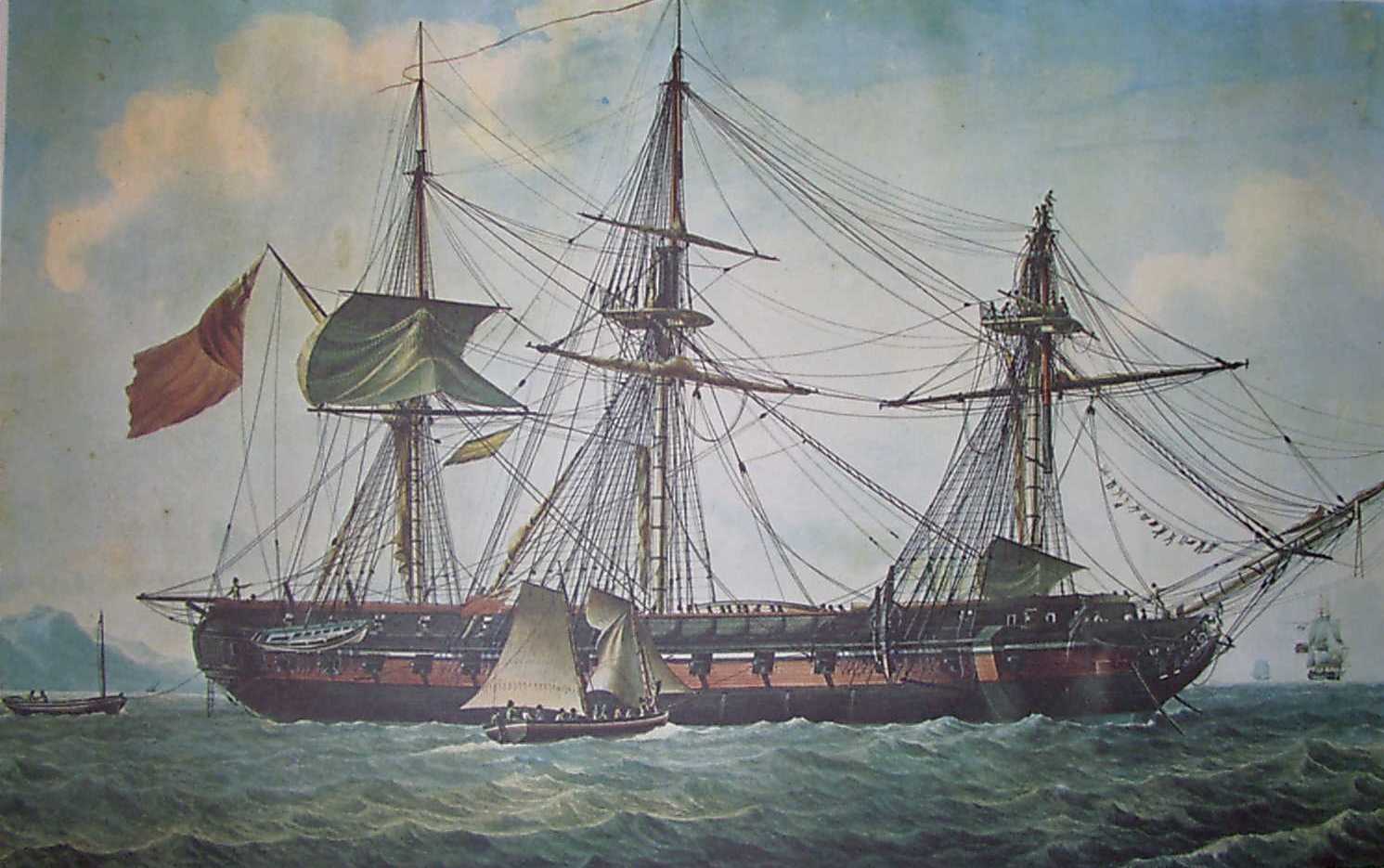|
French Frigate Pénélope (1806)
The ''Pénélope'' was a 44-gun of the French Navy. Commissioned under Captain Bernard Dubourdieu in November 1806, ''Pénélope'' served in the Atlantic for some months. On 21 January 1808, along with , she departed Bordeaux for a cruise to Toulon. They arrived on 28 March, having captured 12 British prizes en route, including the privateer ''Sirene''. On 1 January 1809, command of ''Pénélope'' was transferred to Captain Simonot. In the action of 27 February 1809, she and captured . ''Pénélope'' later took part in the action of 5 November 1813. ''Pénélope'' was decommissioned at the Bourbon Restoration Bourbon Restoration may refer to: France under the House of Bourbon: * Bourbon Restoration in France (1814, after the French revolution and Napoleonic era, until 1830; interrupted by the Hundred Days in 1815) Spain under the Spanish Bourbons: * Ab ..., on 31 August 1815, and was sold for scrap in 1828. Sources and references * Age of Sail frigates of France 1 ... [...More Info...] [...Related Items...] OR: [Wikipedia] [Google] [Baidu] |
Civil And Naval Ensign Of France
{{disambiguation ...
Civil may refer to: *Civic virtue, or civility *Civil action, or lawsuit * Civil affairs *Civil and political rights *Civil disobedience *Civil engineering *Civil (journalism), a platform for independent journalism *Civilian, someone not a member of armed forces *Civil law (other), multiple meanings *Civil liberties *Civil religion *Civil service *Civil society *Civil war *Civil (surname) Civil is a surname. Notable people with the surname include: *Alan Civil (1929–1989), British horn player *François Civil (born 1989), French actor * Gabrielle Civil, American performance artist *Karen Civil (born 1984), American social media an ... [...More Info...] [...Related Items...] OR: [Wikipedia] [Google] [Baidu] |
Penelope
Penelope ( ; Ancient Greek: Πηνελόπεια, ''Pēnelópeia'', or el, Πηνελόπη, ''Pēnelópē'') is a character in Homer's ''Odyssey.'' She was the queen of Ithaca and was the daughter of Spartan king Icarius and naiad Periboea. Penelope is known for her fidelity to her husband Odysseus, despite the attention of more than a hundred suitors during his absence. In one source, Penelope's original name was Arnacia or Arnaea. Etymology Glossed by Hesychius as "some kind of bird" (today arbitrarily identified with the Eurasian wigeon, to which Linnaeus gave the binomial ''Anas penelope''), where () is a common Pre-Greek suffix for predatory animals; however, the semantic relation between the proper name and the gloss is not clear. In folk etymology, () is usually understood to combine the Greek word (), "weft", and (), "face", which is considered the most appropriate for a cunning weaver whose motivation is hard to decipher. Robert S. P. Beekes believed the ... [...More Info...] [...Related Items...] OR: [Wikipedia] [Google] [Baidu] |
Builder's Old Measurement
Builder's Old Measurement (BOM, bm, OM, and o.m.) is the method used in England from approximately 1650 to 1849 for calculating the cargo capacity of a ship. It is a volumetric measurement of cubic capacity. It estimated the tonnage of a ship based on length and maximum beam. It is expressed in "tons burden" ( en-em , burthen , enm , byrthen ), and abbreviated "tons bm". The formula is: : \text = \frac where: * ''Length'' is the length, in feet, from the stem to the sternpost; * '' Beam'' is the maximum beam, in feet. The Builder's Old Measurement formula remained in effect until the advent of steam propulsion. Steamships required a different method of estimating tonnage, because the ratio of length to beam was larger and a significant volume of internal space was used for boilers and machinery. In 1849, the Moorsom System was created in the United Kingdom. The Moorsom system calculates the cargo-carrying capacity in cubic feet, another method of volumetric measurem ... [...More Info...] [...Related Items...] OR: [Wikipedia] [Google] [Baidu] |
18-pounder Long Gun
The 18-pounder long gun was an intermediary calibre piece of naval artillery mounted on warships of the Age of Sail. They were used as main guns on the most typical frigates of the early 19th century, on the second deck of third-rate ships of the line, and even on the third deck of late first-rate ships of the line. Usage As the 18-pounder calibre was consistent with both the French and the British calibre systems, it was used in many European navies between the 17th and the 19th century. It was a heavy calibre for early ships of the line, arming, for instance, the main batteries of in 1636. From the late 18th century, the French Navy used the 18-pounder in three capacities: as the main gun on frigates, as the battery on the upper gundeck of two-deckers, and lastly on the top deck of three-deckers. French frigates began carrying the 18-pounder under Louis XV, when the two frigates, originally designed to carry 24-pounders, were equipped with it; at the time, a typical frig ... [...More Info...] [...Related Items...] OR: [Wikipedia] [Google] [Baidu] |
French Navy
The French Navy (french: Marine nationale, lit=National Navy), informally , is the maritime arm of the French Armed Forces and one of the five military service branches of France. It is among the largest and most powerful naval forces in the world, ranking seventh in combined fleet tonnage and fifth in number of naval vessels. The French Navy is one of eight naval forces currently operating fixed-wing aircraft carriers,Along with the U.S., U.K., China, Russia, Italy, India and Spain with its flagship being the only nuclear-powered aircraft carrier outside the United States Navy, and one of two non-American vessels to use catapults to launch aircraft. Founded in the 17th century, the French Navy is one of the oldest navies still in continual service, with precursors dating back to the Middle Ages. It has taken part in key events in French history, including the Napoleonic Wars and both world wars, and played a critical role in establishing and securing the French c ... [...More Info...] [...Related Items...] OR: [Wikipedia] [Google] [Baidu] |
Bernard Dubourdieu
Bernard Dubourdieu (28 April 1773 – 13 March 1811) was a French rear-admiral who led the allied French-Venetian forces at the Battle of Lissa in 1811, during which he was killed. Life A native of Bayonne, Dubourdieu started sailing on a merchantman at 16, before joining the Navy in 1792. He quickly rose to ensign aboard the ''Entreprenant''. He transferred to the frigate ''Topaze'' the next year in Latouche-Tréville's squadron. Captured at Toulon by the British and transferred to Gibraltar, he escaped to Lorient. Promoted to ''enseigne de vaisseau'', Dubourdieu sailed on the corvette ''Gaieté''. ''Gaieté'' was captured and Dubourdieu was imprisoned again until 1799. Captured a third time in Alexandria in 1800, he was exchanged and promoted to ''lieutenant de vaisseau''. In 1805, he was made a ''capitaine de frégate''. In 1807, he took command of the frigate ''Pénélope'' and captured thirteen British merchantmen. In the action of 27 February 1809 The action of ... [...More Info...] [...Related Items...] OR: [Wikipedia] [Google] [Baidu] |
Action Of 27 February 1809
The action of 27 February 1809 was a minor naval engagement during the French Revolutionary Wars. Two 44-gun frigates, ''Pénélope'' and ''Pauline'', sortied from Toulon harbour to chase a British frigate, HMS ''Proserpine'', which was conducting surveillance of French movements. First sneaking undetected and later trying to pass herself as a British frigate coming to relieve ''Proserpine'', ''Pénélope'' approached within gun range before being identified. With the help of ''Pauline'', she subdued ''Proserpine'' and forced her to surrender after a one-hour fight. ''Proserpine'' was sailed to Toulon and commissioned in the French Navy, where she served until 1865. Captain Otter remained a prisoner in France until the end of the war; he was court martialed for the loss of his ship on 30 May 1814, and honourably acquitted. Background By 1809, the French fleet in Toulon was blockaded by several British squadrons of powerful ships of the line; direct surveillance of the harbour ... [...More Info...] [...Related Items...] OR: [Wikipedia] [Google] [Baidu] |
Action Of 5 November 1813
The action of 5 November 1813 was a brief naval clash during the Napoleonic Wars, between part of the British Mediterranean Fleet led by Vice-Admiral Sir Edward Pellew, and a French force under Rear-Admiral Julien Cosmao-Kerjulien. The engagement took place outside the French port of Toulon. The clash occurred when a French fleet under Vice-Admiral Maxime Julien Émeriau de Beauverger took advantage of a favourable wind and the temporary absence of the British blockading force, to leave port to carry out exercises. Émeriau abandoned the exercises when the wind changed, but while returning to port his rear came under attack from the recently returned British inshore squadron. The British attack was reinforced by newly arrived ships from the main fleet, but the French were able to escape into Toulon after exchanging cannon fire with the British. Casualties on both sides were light. Background The French Mediterranean Fleet had been blockaded in their principal base at Toulon fo ... [...More Info...] [...Related Items...] OR: [Wikipedia] [Google] [Baidu] |
Bourbon Restoration In France
The Bourbon Restoration was the period of French history during which the House of Bourbon returned to power after the first fall of Napoleon on 3 May 1814. Briefly interrupted by the Hundred Days War in 1815, the Restoration lasted until the July Revolution of 26 July 1830. Louis XVIII and Charles X, brothers of the executed king Louis XVI, successively mounted the throne and instituted a conservative government intended to restore the proprieties, if not all the institutions, of the Ancien Régime. Exiled supporters of the monarchy returned to France but were unable to reverse most of the changes made by the French Revolution. Exhausted by decades of war, the nation experienced a period of internal and external peace, stable economic prosperity and the preliminaries of industrialization. Background Following the French Revolution (1789–1799), Napoleon Bonaparte became ruler of France. After years of expansion of his French Empire by successive military victories, ... [...More Info...] [...Related Items...] OR: [Wikipedia] [Google] [Baidu] |
Antoine Roux
Ange-Joseph Antoine Roux, "Antoine Roux" (1765–1835) was a French fine art painter who specialised in maritime painting, sometimes referred to as marine art. Career Roux came from a family of artists and primarily worked in Marseille. Early in life he was apprenticed to his father, Joseph Roux (1752–93), a hydrographer as well as an artist in his own right, spending his leisure hours painting and drawing.The Sketchbooks of Antoine Roux , Peabody Essex Museum, 2006. French galley at Marseilles (PAG9744) '', National Maritime Museum, Greenwich, London. Antoine died of cholera in Marseille in 1835. [...More Info...] [...Related Items...] OR: [Wikipedia] [Google] [Baidu] |
Age Of Sail Frigates Of France
Age or AGE may refer to: Time and its effects * Age, the amount of time someone or something has been alive or has existed ** East Asian age reckoning, an Asian system of marking age starting at 1 * Ageing or aging, the process of becoming older ** Senescence, the gradual deterioration of biological function with age ** Human development (biology) * Periodization, the process of categorizing the past into discrete named blocks of time ** Ages of Man, the stages of human existence on the Earth according to Greek mythology and its subsequent Roman interpretation ** Prehistoric age Places * AGE, the IATA airport code for Wangerooge Airfield, in Lower Saxony, Germany People * Åge, a given name * Aage, a given name * Agenore Incrocci, an Italian screenwriter Arts, entertainment, and media Fictional entities * ''Ages'', worlds in the ''Myst'' video game series Music * "Age" (song), a song by Jim and Ingrid Croce Periodicals * ''Age'' (journal), a scientific journal on ageing, ... [...More Info...] [...Related Items...] OR: [Wikipedia] [Google] [Baidu] |




